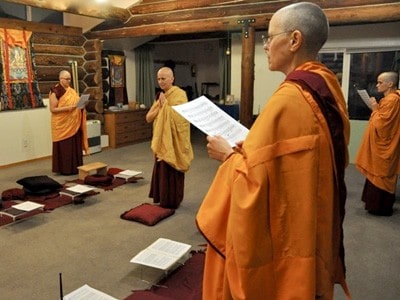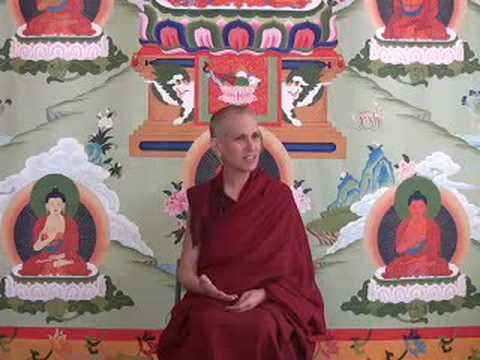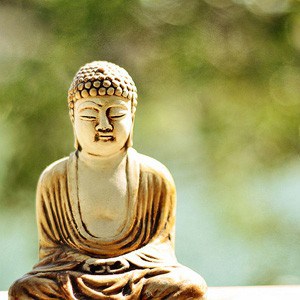The challenge of the future
The challenge of the future, Page 3

How will the sangha fare in North American Buddhism?
Let me now sum up the territory I have covered. I have briefly sketched four characteristics of contemporary spirituality, ushered in by the transformation from a traditional to a modern or even post-modern culture. These characteristics have had a profound influence on mainstream religion in the West and have already started to alter the shape of Buddhist spirituality. The four are:
- The “leveling of distinctions,” so that the sharp distinctions between the ordained religious person and the lay person are being blurred or even abolished.
- The rise of “secular spirituality” or “spiritual secularity,” marked by a shift in the orientation of religion away from the quest for some transcendent state, a dimension beyond life in the world, towards a deep, enriching experience of the human condition and a transformative way of living within the world.
- The conviction that the mark of authentic religious faith is a readiness to engage in compassionate action, especially to challenge social and political structures that sustain injustice, inequality, violence, and environmental despoliation.
- Religious pluralism: abandoning the claim to exclusive religious truth and adopting a pluralistic outlook that can allow the possibility of complementary, mutually illuminating perspectives on religious truth and practice. This applies both to the relations of Buddhists with followers of other religions, and to the internal relations between followers of different Buddhist schools and traditions.
I now want to suggest that all four of these factors are going to present powerful challenges to Buddhist monasticism in the future, forcing us to rethink and re-evaluate traditional attitudes and structures that have sustained monastic life for centuries right up to the present. Indeed, these challenges have already been recognized in many quarters and the task of reshaping monasticism in response to them has already started.
As I said at the beginning of my talk, I am not going to advocate a fixed response to these challenges which I think is uniquely correct; for, as I said, I don’t have an unambiguous conviction about the best response. But to help us grapple with them, I want to posit, in relation to each of these four challenges, a spectrum of possible responses. These range from the conservative and traditionalist at one end to the liberal and accommodative on the other.
(1) Thus, with respect to “the leveling of distinctions,” we have at one end the traditionalist insistence on the sharp stratification of monastics and lay person. The monastic person is a field of merits, an object of veneration, alone entitled to claim the position of Dharma teacher; the lay person is essentially a supporter and devotee, a practitioner and perhaps an assistant in teaching activities, but always in a subordinate role. At the other end, the distinction between the two is almost erased: the monk and lay person are simply friends; the lay person might teach meditation and give Dharma talks, perhaps even conduct religious rites. Towards the middle we would have a situation in which the distinction between monastic and lay person is preserved, in which lay people accord the monastics traditional forms of respect, but the capacity for lay people to study and practice the Dharma extensively and in depth is well acknowledged. From this point of view, those who have fulfilled the requisite training, whether monastics or laypeople, can function as Dharma teachers, and independent lineages of lay teachers, not dependent on monastics, can be accepted and honored.
(2) Again, among the responses to the secularist challenge, we can see a spectrum. At one end is a traditionalist monasticism that emphasizes the classical teachings of karma, rebirth, the different realms of existence, etc., and sees the goal of monastic life to be the total ending of cyclic existence and the attainment of transcendent liberation. At the other end is a monasticism influenced by secularizing tendencies, which emphasizes the enrichment and deepening of immediate experience as sufficient in itself, perhaps even as “nibbana here and now” or the actualization of our Buddha-nature. Such an approach, it seems to me, is already found among some Western presentations of Soto Zen, and also seems to have gained currency in the way Vipassana meditation is taught in lay meditation circles. Between these two extremes, a centrist approach might recognize the mundane benefits of the Dharma and stress the value of acquiring a richer, deeper experience of the present, but still uphold the classical Buddhist framework of karma, rebirth, renunciation, etc., and the ideal of liberation from rebirth and attainment of world-transcendent realization. Again, whether this be understood from a Theravadin or Mahayanist point of view, a common stratum unites them and supports their respective monastic projects.
(3) With regard to engaged spirituality, at the conservative end of the spectrum we find those who look critically at engaged Buddhist practices for monastics, holding that a proper monastic life requires a radical withdrawal from mundane activities, including all direct involvement in social, political, and economic action. The monastic can teach lay people the ethical values that conduce to greater social justice but should not become tainted by involvement with projects aimed at social and political transformations. At the other end are those who believe that monastics should be actively engaged in such activities, indeed that they should be at the forefront of the struggle for peace and social, economic, and political justice. A middle position might recognize the importance of developing a Buddhism that engages more fully with the world, but holds that monastics should serve as guides, sources of inspiration, and educators in programs of social engagement, while the hands-on work of dealing with governments, policy makers, and institutions should generally be entrusted to lay Buddhists.
(4) Finally, with respect to religious pluralism, we find, at the conservative end of the spectrum, monastics who believe that Buddhism alone has the ultimate truth and the unique path to spiritual liberation. Since those following other religions are immersed in wrong views, we have nothing to learn from them and would do best to avoid religious discussions with them except to persuade them of their errors. We can cooperate on projects aimed at worthy ends, such as world peace and environmental awareness, but there is no point exploring our religious differences, for such discussions lead nowhere. Conservative followers of a particular school of Buddhism might bring forth similar considerations in relation to Buddhists belonging to other schools. At the liberal end of the spectrum are monastics who believe that all religions teach essentially the same thing, and that it does not particularly matter which path one follows, for they all lead to the same goal. In the middle, we might find those who, while upholding the uniqueness of the Buddha’s teaching, also believe in the value of inter-religious dialogue, who recognize elements of truth and value in other religions, and who might be willing to live for periods in monasteries of another religion, or in monasteries belonging to a school of Buddhism different from that in which they have been trained.
It should be noted that while I designate certain positions as conservative and others as liberal, it is not necessary that the four conservative positions constitute an inseparable cluster and the four liberal and four middling positions other inseparable clusters. It is quite possible for one who takes a conservative position on one, two, or three of these issues to take a liberal or middling position on the fourth. Someone might take a conservative position on two issues and a middling or liberal stance on the other two. And conversely, taking the liberal and middling position as our basis, we can posit numerous combinations between them and conservative positions on the four issues. Thus a great number of permutations is possible.
In considering the different positions, the approach that seems to me most wholesome is one that conforms to the spirit of the middle way: on the one hand, avoiding rigidly clinging to long- established conventions and attitudes simply because they are familiar to us and give us a sense of security; on the other hand, exercising care not to lose sight of the basic principles of the Dharma, especially those that derive from the Buddha himself, just to accommodate new social and cultural conditions. In the end, it might be best that new forms evolve gradually in response to the new conditions we meet here in the West rather than through hasty decisions. Monasticism is, in any case, generally a fairly conservative force. This may be partly due to the temperament of those who ordain, partly due to the fact that Buddhist monasticism is an ancient institution— older than all the empires and kingdoms that have risen upon the face of the earth—and thus has acquired a weight that discourages random experimentation. In any case, the good Dharma flourishes to the extent that we remain firm in our commitment to the core principles of Buddhism as a whole and those that define our respective traditions while at the same time remaining open to the challenges, insights, and values of contemporary civilization.
But one point is certain: To preserve relevance, the sangha must allow the forms and expressions of Buddhist monasticism to respond effectively to the new and unique challenges we face today. Our response should be marked by faith, flexibility and resiliency. Faith roots us in the Dharma, but it should not stiffen us. Flexibility allows us to adapt and thereby to keep in touch with the concerns of ordinary people; it is not a mark of weakness. To the contrary, with firm roots, we can bend with the wind without breaking and collapsing.
The challenges we face today can be seen, not as threats and dangers, but as calls to discover more deeply and authentically what it means to be a monastic in the contemporary world, which is so different from the world in which Buddhism was born. Changes in forms and structures, in roles and ways of conducting our monastic lives, can be positive and healthy, a sign of the inner vitality of Buddhism and of our own confidence in the spiritual quest. We can look upon the changes that occur in response to the new challenges as the next step in the onward evolution of Buddhist monasticism, as the next bend in the river of the Dharma as it flows onward from its ancient Asian homelands into the uncharted frontiers of the global 21st century.
Bhikkhu Bodhi
Bhikkhu Bodhi is an American Theravada Buddhist monk, ordained in Sri Lanka and currently teaching in the New York/New Jersey area. He was appointed the second president of the Buddhist Publication Society and has edited and authored several publications grounded in the Theravada Buddhist tradition. (Photo and bio by Wikipedia)


